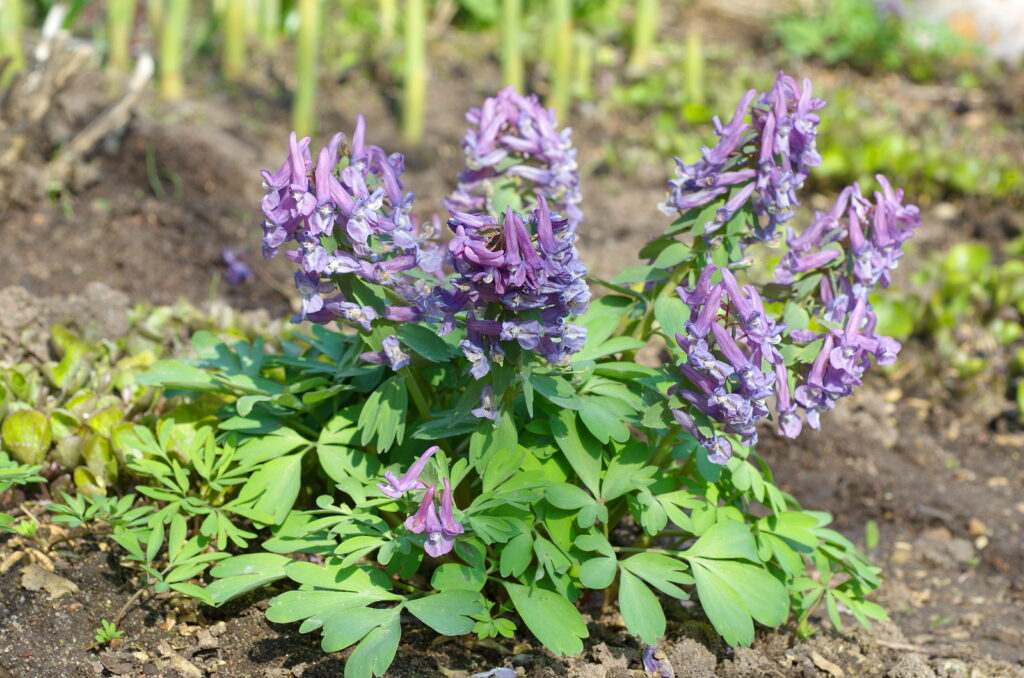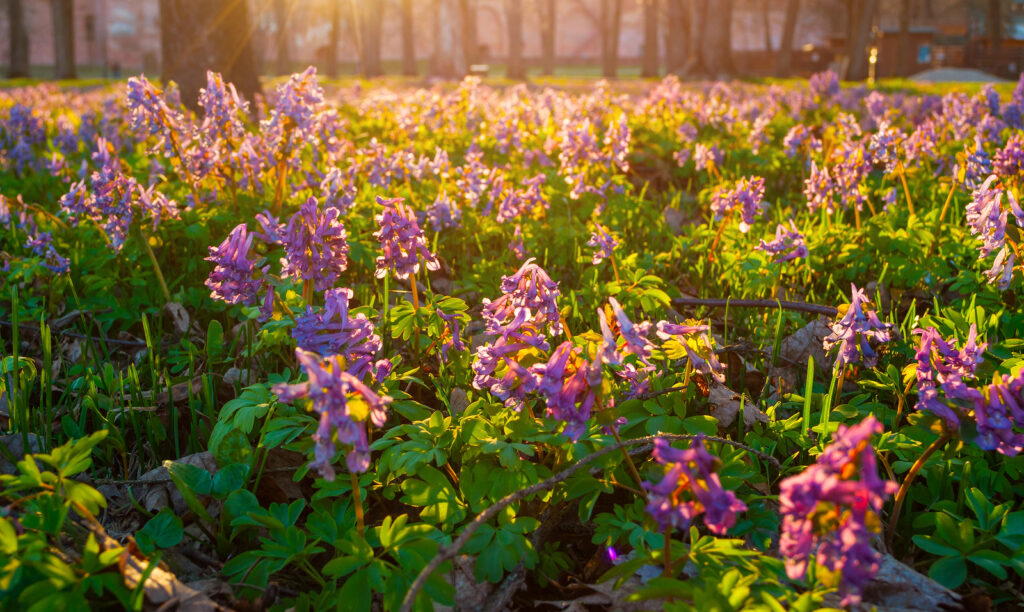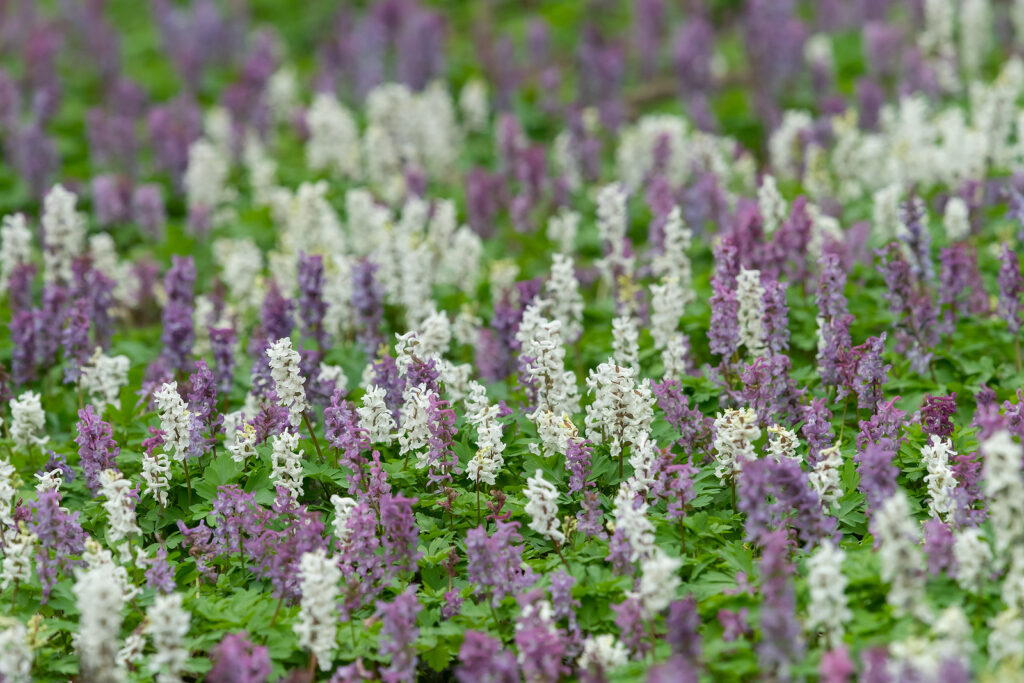Corydalis–commonly called Fumewort–has irregular yellow, blue, purple, or rose flowers that resemble those of the bleeding heart. Fumewort is easy to grow in ordinary garden soil.
Corydalis produces mounds of delicate-looking ferny foliage. Tubular and spurred flowers appear on racemes. Perennial varieties grow from rhizomes or tubers.
Most Corydalis do not like being transplanted. They can be dug and divided for propagation in early spring or early fall. Most Corydalis will self sow.

Get to know Corydalis
- Plant type: Perennial; fleshy rooted and tuberous and rhizomatous
- Growing Zones and range: Zones 4 to 8
- Hardiness: Plants will die back where summers are hot,
- Height and width: 10 to 16 inches (25-40cm) tall; 8 to 14 inches (20-35cm) wide
- Foliage: Often finely divide leaflets with a fern-like appearance
- Flowers: Tubular white and yellow flowers resemble the bleeding heart flower; flowers have four petals with a spur
- Bloom time: Late spring to mid-summer; in cool regions will bloom until the first frost in fall
- Uses: Plant in dappled shade bed or border; woodland gardens; there are sun-loving species that can be used in alpine or rock gardens
- Common name: Fumewort
- Botanical name: Corydalis spp.
- Family: Papaveraceae
Where to plant Corydalis
- Corydalis grows well in partial shade.
- Corydalis will grow in average to humus-rich soil that is well-drained. Fumewort like gravelly soil. It can tolerate alkaline soil.

When to plant Corydalis
- Set Corydalis tubers 3 inches (7.6cm) deep in fall or set out established plants in spring.
Planting and spacing Corydalis
- Space Corydalis 8 to 12 inches (20-30cm) apart.
- Set tuberous plants inch deep.]
- Sow seed 1/8 inch deep in evenly prepared soil.
How to water and feed Corydalis
- Grow Corydalis in moist soil; keep the soil evenly moist.
- Fertilize Corydalis on occasion with an all-purpose fertilizer,
Corydalis care
- Divide Corydalis in fall every 2 or 3 years as needed.
- Corydalis does not like being transplanted; take divisions in spring.
Corydalis pests and diseases
- Downy mildew and rust can occur.
- Slugs and snails can damage plants.

Corydalis propagation
- Corydalis can be propagated by seed or division.
- Divide spring-flowering species in autumn and summer-flowering species in spring.
- Corydalis seeds will germinate in 60 to 90 days at 70°F (21°C); do not cover the seeds, simply press them into the soil and then keep the soil just moist until sprouts appear.
Corydalis varieties to grow
- Corydalis cava is tuberous species that grows to 8 inches tall with dense racemes of rosy-purple or white flowers from spring to summer.
- C. cheilanthifolia, ferny corydalis produces 12-inch mounds of lacy leaves and bears racemes of bright yellow flower from spring to summer.
- C. diphylla is a tuberous species that grows to 6 inches tall with lacy leaves and loose clusters of white flowers with red-purple lips; a good choice for rock gardens.
- C. flexuosa is a summer dormant perennial; blooms from spring to early summer; it has neon blue flowers on 12-inch (30cm) mounds; cultivar ‘Blue Panda’ has brilliant blue flowers on 8-inch mounds.
- C. fumariifolia is species that grow to 18 inches tall and wide; bears racemes of blue to purple-blue flowers in late spring to early summer.
- C. lutea is a mound-forming evergreen perennial with fern-like arching leaves; blooms from late spring to early autumn; golden yellow flowers appear on terminal racemes.
- C. ochroleuca produces 12-inch mounds of ferny leaves topped with racemes of white flowers with yellow throats; blooms spring to summer.
- C. sempervirens is an annual with brilliant pink and yellow flowers.
- C. solida grows to 10 inches tall with clusters of purplish-red flowers in early spring.















